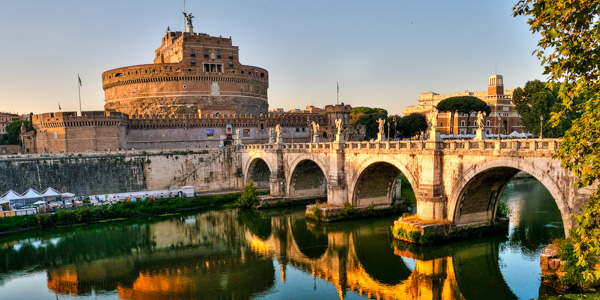
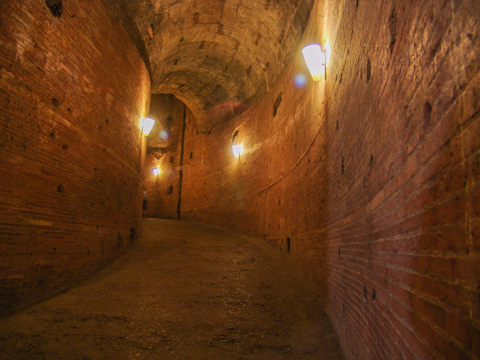 From Hadrian's Tomb a ramp winds up to the castle.
From Hadrian's Tomb a ramp winds up to the castle.By the AD 2nd century, the Imperial tomb that Augustus had built along the Tiber was nearly full of emperors and their families.
The Emperor Hadrian decided to start over and build himself a grand new tomb across the riveraround AD 120. Every emperor from Hadrian himself down to Septimius Severus was interred inside.
Today, you enter the site via the ancient mausoleum deep in its heart. You then follow a sloping, curving corridor that slowly brings you into the fortress that, in later centuries, was built in top of the tomb.
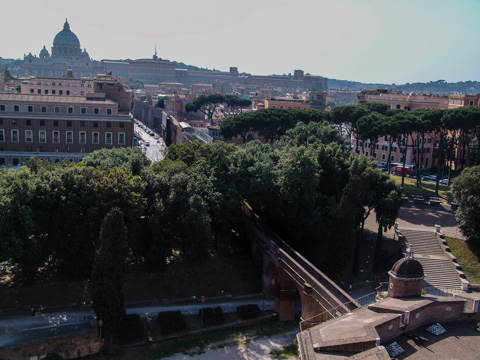 The passetto (private papal passage) between Castel Sant'Angelo and St. Peter's.
The passetto (private papal passage) between Castel Sant'Angelo and St. Peter's.The tomb was a massive round structure, which it turned out made a great base for fortifications, and by the Middle Ages the tomb had gradually become Rome's greatest castle, and eventually, the papal military stronghold.
This massive brick cylinder is connected to the Vatican by a raised viaduct called the passetto, a tunnel once used by troops and the pope to spirit back and forth in secrecy and safety.
Although it got its name in 590 when St. Gregory the Great had a vision of an angel sheathing its sword atop the ramparts to predict the end to a plague sweeping the city, the castle's most colorful episode occurred in 1527.
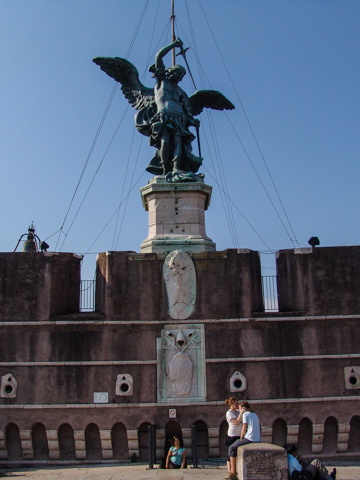 St. Michael the Archangel atop Castel Sant'Angelo.
St. Michael the Archangel atop Castel Sant'Angelo.The pope and the German emperor were at war.
When Charles V's imperial troops entered Rome and began to sack the city, Medici pope Clement VII hitched up his robes and scurried down that passetto viaduct to the safety of Castel Sant'Angelo—leaving three-quarters of his elite Swiss Guards behind to die covering his escape.
Benvenuto Cellini, Florentine goldsmith, talented sculptor, and insufferable braggart, happened to be on hand and wrote about the ensuing battle in his swashbucklingly entertaining Autobiography (see sidebar for an excerpt).
If he's to be believed, Cellini single-handedly saved the pope, castle, and indeed the city of Rome itself that day, taking control of the cannon and firing away when he saw that the Roman bombardiers, fearful they might hit their own homes, were cowering and sobbing.
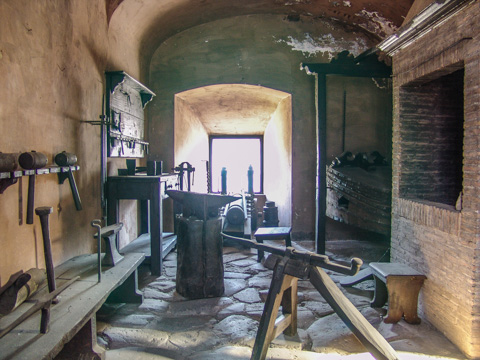 The armory museum of Castel Sant'Angelo.
The armory museum of Castel Sant'Angelo.Today the castle is a museum, and you enter through Hadrian's tomb itself to climb the original, 2nd-century brick-walled spiraling ramp. The ramp becomes a stair and then a catwalk as it passes through the travertine pocket of Hadrian's burial chamber.
The castle is slowly being transformed into a space for temporary exhibitions, so the layout is a bit muddled as they move the old, more permanent exhibits around.
There are lots of good views of the Tiber and the statue-lined Ponte Sant'Angelo from the ramparts.
Sunset Views
One nice thing about the Castel Sant'Angelo is that it remains open pretty late—to 10pm most nights, 8pm on Sundays—making it a great place to save for the end of the day, and to take in the sunset over the Tiber River and the city of Rome from the ramparts.
The eclectic collections tucked away in rooms throughout the complex range from an AD 2nd-century bust of Hadrian and 16th-century ceiling frescoes of the emperor's exploits to majolica dating back to the 1300s, a 17th-century painting of a Bacchanale by Poussin, stacks of stone cannonballs, and even an enormous wooden crossbow that fired javelins.
Also still here are several rooms filled with arms and armor ranging from 6th-century BC Etruscan gladiator's helmets to an officer's uniform of 1900, with some deadly swords, daggers, spears, guns, pikes, halberds, and the likes in between. Be on the lookout for the pair of enormous, 16th-century inlaid ivory-handled revolvers.
Unfortunately, the bulk of the collections that once made up this impressive military museum has found its way to semi-permanent retirement in a basement storeroom to free up more temporary exhibition space in the castle.
Lungotevere Castello 50
tel. +39-06-681-9111 or +39-06-32-810
www.castelsantangelo.com
Open daily 9am–7:30pm
Ticket office closes 1 hour before
€10* (subject to change during exhbits; free the first Sun of the month)
Roma Pass: Yes (free, or save 33%)
Bus: 280, 492, 40, 23, 34, 62, 271, 982, N11
Metro: Ottaviano (A)
Hop-on/hop-off: Vaticano
Planning your day: The castle takes a least an hour to wander through—more like 90 minutes, especially as it's nice just to sit on the battlements and drink in the city panoramas. Also, there's a pleasant little cafe with outdoor tables up on one of the ramparts. » Rome itineraries
Roma Pass for free admission or a discount. » more
Take a guided tour of Castel
Sant'Angelo with one of our partners:
Share this page
Search ReidsItaly.com
Lungotevere Castello 50
tel. +39-06-681-9111 or +39-06-32-810
www.castelsantangelo.com
Open daily 9am–7:30pm
Ticket office closes 1 hour before
€10* (subject to change during exhbits; free the first Sun of the month)
Roma Pass: Yes (free, or save 33%)
Bus: 280, 492, 40, 23, 34, 62, 271, 982, N11
Metro: Ottaviano (A)
Hop-on/hop-off: Vaticano